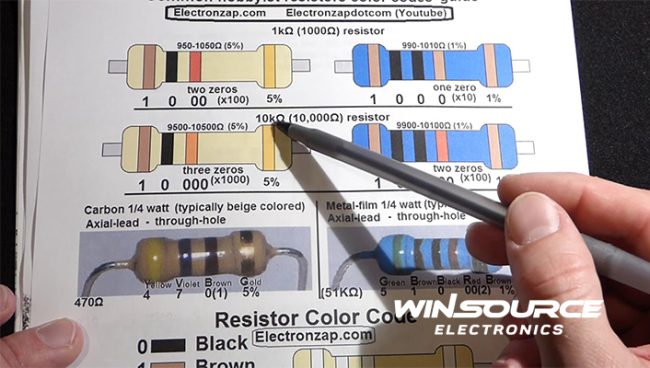
The world of electronics is filled with components that play crucial roles in circuitry.
Among them, the 1k resistor stands out as a fundamental building block.
In this article, our electronics gurus here at WIN SOURCE will delve into the significance of the 1k resistor, exploring its characteristics, applications, and why it’s a staple in electronic design.
Let’s get the short answer before heading into more details.
A 1k resistor, or 1 kilohm resistor, is a fundamental electronic component with a resistance value of 1000 ohms. Widely used in circuits, it serves roles in voltage dividers, current limiting, digital pull-up/down, filters, and more, contributing to diverse electronic applications.
Ok, so now we have the takeaway in place, let’s begin by exploring some background.
Understanding the Basics
A 1k resistor, short for 1 kilohm resistor, is a passive two-terminal component that restricts the flow of electric current.
Its resistance is measured in ohms, and in the case of the 1k resistor, that value is 1000 ohms.
This seemingly unassuming component finds its place in a wide array of electronic circuits, contributing to the stability and functionality of various devices.
Applications in Voltage Dividers
One of the primary applications of the 1k resistor is in voltage divider circuits.
When paired with another resistor, it creates a voltage divider that allows precise control over voltage levels.
This is crucial in applications where maintaining a specific voltage is essential, such as analog sensors and signal conditioning circuits.
Current Limiting and LED Protection
Another notable application is current limiting.
The 1k resistor is often employed to limit the current flowing through LEDs, preventing them from drawing too much power and potentially burning out.
This simple but effective technique ensures the longevity and reliability of LED-based components in electronic designs.
Pull-Up and Pull-Down Resistors
In digital electronics, the 1k resistor plays a vital role as a pull-up or pull-down resistor.
These resistors are crucial for stabilizing the voltage level of a signal line when it’s not actively being driven high or low by a component.
This helps prevent unwanted signal fluctuations and enhances the overall reliability of digital circuits.
Temperature Stability and Tolerance
When selecting resistors for electronic designs, the 1k resistor’s temperature stability and tolerance are important factors to consider.
These resistors typically have a tolerance of around 1%, meaning their actual resistance can deviate by up to 1% from the specified value.
This level of precision is crucial in applications where accuracy is paramount.
Integration in Microcontroller Interfacing
The 1k resistor is a crucial component in microcontroller interfacing and plays a role in protecting input pins from excessive current.
When interfacing with external sensors or devices, using the 1k resistor as part of a series resistor network safeguards the microcontroller by limiting the current that can flow into its input pins.
This protective measure prevents potential damage to the microcontroller and ensures robust communication between the microcontroller and external components.
The 1k resistor’s ability to strike a balance between providing protection and maintaining signal integrity makes it a valuable component in the realm of microcontroller-based projects and embedded systems.
The Role in Filter Circuits
Beyond voltage dividers and current limiting, the 1k resistor finds a place in filter circuits.
Filters are essential for shaping and refining signals in electronic systems.
By combining resistors with capacitors, engineers can design low-pass, high-pass, or band-pass filters to tailor the frequency response of a circuit.
The 1k resistor, with its moderate resistance value, becomes a key player in determining the cutoff frequencies and shaping the overall filter characteristics.
Implications in Feedback Networks
In feedback networks, the 1k resistor plays a pivotal role in controlling gain and stabilizing amplifier circuits.
Whether in operational amplifiers or other amplifier configurations, resistors, including the 1k variant, are strategically placed to set the feedback ratio.
This control over feedback helps regulate the gain of the amplifier, ensuring stability and preventing unintended oscillations.
Precision in Wheatstone Bridge Configurations
In precision measurement circuits, such as Wheatstone bridges, the 1k resistor contributes to achieving accurate and reliable readings.
These configurations are commonly used in strain gauges, temperature sensors, and other sensors requiring precise measurements.
The 1k resistor, with its well-defined resistance value, aids in balancing the bridge and providing a stable reference point for accurate sensor readings.
Influence on Time Constants in RC Circuits
Time constants in RC (resistor-capacitor) circuits are crucial for determining how quickly a circuit responds to changes.
The 1k resistor, when paired with a capacitor, influences the time constant and thus the charging or discharging rates in these circuits.
This dynamic is vital in applications like signal shaping, timing circuits, and pulse-width modulation.
Demystifying the 1k Resistor – To End With…
The 1k resistor is a versatile and essential component that plays a multifaceted role in electronic circuits.
Its applications span from fundamental voltage dividers to intricate filter designs, amplifier stability, precision measurements, and time-constant control.
The ability to precisely control electrical parameters makes the 1k resistor a cornerstone in electronics, embodying the principle that even seemingly simple components are integral to the intricate dance of electrons that power our modern devices.
As technology evolves, the 1k resistor continues to be a steadfast companion for engineers, contributing to the advancement and reliability of electronic systems worldwide.
For all your home hobbyist or professional engineering projects, head over to our store to find industry-leading manufacturers and high-quality electronic devices.
© 2024 Win Source Electronics. All rights reserved. This content is protected by copyright and may not be reproduced, distributed, transmitted, cached or otherwise used, except with the prior written permission of Win Source Electronics.

COMMENTS